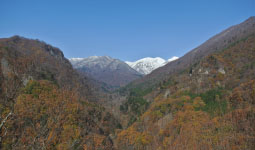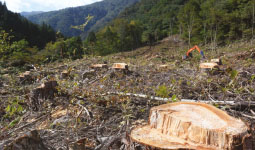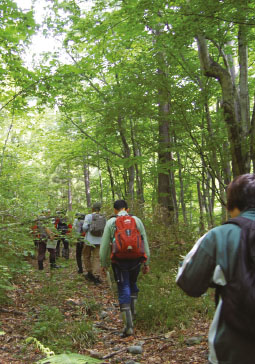Home > Highlighting JAPAN > Highlighting Japan November 2018 > Living In Tune with Nature: Japan's Connection to Wood
Highlighting JAPAN


Community Building in the Forest of the Golden Eagles
Located north of Minakami Town in Gunma Prefecture, the Akaya Forest is a national forest of about ten thousand hectares that is home to many types of precious wildlife. The AKAYA Project is taking action to restore and preserve the health of the forest and its inhabitants.
The AKAYA Project is made up of three groups—the Akaya Project Regional Council (formed by local residents), the Forestry Agency’s Kanto Regional Forest Office, and The Nature Conservation Society of Japan. “The forest of Akaya is 1.6 times larger than the area contained within the Yamanote Line that encompasses central Tokyo,” explains one project member, Hirotaka Matsui. “The AKAYA Project aims to reconstruct the ecosystem while creating a sustainable community. There are seven working groups, such as mammal monitoring and mountain stream restoration, working to obtain scientific data about environmental changes.”
The highlight of this project is the drive to protect the golden eagles that live there, which are listed as an endangered species—there are only around two hundred breeding pairs and five hundred individual birds. In the past it was possible to spot these massive birds spreading their two-meter-wide wings and soaring through the skies of Japan, but this may soon no longer be the case. The hypothesis is that the increase of manmade forests led to their endangerment.
“From the 1960s to 1980s, the country’s forest expansion project created many manmade forests throughout Japan, planting trees close together,” says another member of the AKAYA Project, Seiichi Dejima. “Later, when wood was being sourced from outside of Japan, these manmade forests continued to expand uncontrolled, which made it difficult for the golden eagle to find its prey from above.”
There is one pair of golden eagles living in the forest of Akaya. To help and protect them, project members cut about two hectares of manmade forest in September 2015. As the natural forest returned, it became easier for the golden eagles to hunt.
After this first logging experiment, one chick was spotted flying out of the golden eagles’ nest in June 2016—the first in seven years. By November 2017, members of the project even saw a golden eagle hunting. It appears that the rate of the birds being spotted has increased significantly. “We can’t say clear-cutting the manmade forest is directly connected to this result, but it is definitely a positive result,” Dejima states. He also mentions that they are striving to make hunting easier for the birds.
The children of Minakami are the ones who most frequently spot the golden eagles in the forest. To make these young future environmentalists proud of their hometown, the projects creates opportunities for them to observe the golden eagles alongside local adults and learn more about them from The Nature Conservation Society of Japan, which has been monitoring the status of the raptors for around thirty years.
Dejima is pleased to see that golden eagle statues have been placed in tourist spots and that the bird is now considered the symbol of Minakami. And thanks to the AKAYA movement, a local workshop that once produced blue and red castanets started creating wooden castanets using Akaya’s special trees.
“The trees are a precious natural resource, and we should use them wisely. If people know where the wood is sourced from and how doing so helps protect the golden eagles, perhaps they will view this as added value and stop relying on imported wood,” Dejima says hopefully.
It will likely take a century to clear the manmade forest and restore the natural one. Unfortunately, those who are involved in the golden eagle protection project will not see it. Dejima laughs. “It’s a bit of a far-off dream. These are just the first steps, and it is a project with many uncertainties.”
Still, seeing a young golden eagle soaring after seven years brings a sense of hope for the future. With the dream of spreading this project beyond Akaya throughout Japan, the AKAYA Project will continue to protect the wonderful natural environment and make a community that children can be proud of.
© 2009 Cabinet Office, Government of Japan










